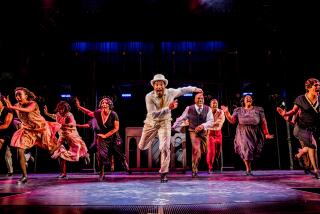O.C. Pop Music Review : Lotta Shakin’ as Jerry Lee Lewis Rocks Knott’s
- Share via
BUENA PARK — There was a sight that neared rock and roll epiphany at Knott’s Berry Farm on Saturday. Set to play on an outdoor stage in the park’s ghost town, Jerry Lee Lewis was given a dressing room in an adjacent building. Hence, when the Killer emerged to go onstage, it was from the ghost town’s hearse-bracketed undertaking parlor that he came striding, a pipe clamped resolutely between his teeth.
Don’t count on Lewis not doing the same at his own funeral. Aside from being briefly eclipsed by Keith Richards in the ‘70s, he has always headed rock’s most-likely-to-be-dead-real-soon list. He has left burning pianos and autos in his wake, brawled with the law and drunk whole states dry. Doctors have removed enough of his internal organs to make up a whole other person. And during one hospitalization, his relatives announced his impending death.
Hell, just to be near Jerry Lee is such a health hazard that it would probably be easier to insure a steak at a pit bull kennel: Wives have died; Lewis once shot a bass player in the stomach, and if the Memphis police hadn’t stopped him the night he turned up at Graceland with a derringer, Lewis might have made all the speculation over how Elvis died unnecessary.
He often has declared with a certitude that he is going straight to hell.
Yet, however much he may have flirted with oblivion, the Killer remains one of the most uniquely alive performers in rock. It hardly mattered that the park halted its train ride during the concert, as Lewis provided all the locomotion anyone could ask for. And even his two brief 30-minute appearances at Knott’s were sufficient to display that he is one of the greatest stylists American music has produced.
Appearing trim and chipper in a quilted western shirt, blue jeans and gleaming black cowboy boots, Lewis got down to business in the first show with a machine-gun-like vocal on Chuck Berry’s “Roll Over Beethoven.” Though most of his selections were songs made indelibly famous by other artists--including Ray Charles’ “What’d I Say,” Little Richard’s “Lucille,” Elvis’ “Jailhouse Rock” and Hank Williams’ “Your Cheating Heart”--Lewis completely recast each of them. His “What’d I Say” started with a slow, stately piano figure, built very loosely from Charles’ single-note vamp and then jumped about three gears into a rampaging barrelhouse tempo.
It’s a good thing that Lewis’ tight quartet has survived several years with him because it takes a special outfit to handle the sudden segues and stylistic changes Lewis is prone to. One second he was pounding out “Blue Suede Shoes,” and the next he had stopped the music dead to reminisce about Carl Perkins. During a plaintive, melodically daring vocal reinterpretation of “Over the Rainbow,” he dragged a couple of lines out to include references to his cousin, televangelist Jimmy Swaggart.
At one point in the first show he addressed the keys of his electric grand piano with a hurled piano stool, and his hands were scarcely less contemptuous of the keyboard. But what a tremendous contempt it is, with his avalanche glissandi and hammered upper-register attacks seeming like the pianistic version of Zeus carelessly deigning to hurl dazzling thunderbolts to the world below.
For all the times he has performed his ‘50s hits--and 10,000 times apiece wouldn’t be an unlikely number--Lewis’ “High School Confidential,” “Whole Lotta Shakin’ Goin’ On” and “Great Balls of Fire” remained unfettered celebrations, with his performances of those last two songs varying even between his two shows.
His second performance of “Whole Lotta Shakin’ ” (still one of the most salacious songs ever waxed) made a grand argument against drum machines. Beginning at a slow tempo, the song haphazardly picked up speed, and excitement, until it collided into a breakneck “Great Balls of Fire,” where Lewis kicked back his stool, played the piano with his elbow and rump, and set his still-wavy hair flying as if it was the official flag of rock and roll.
More to Read
The biggest entertainment stories
Get our big stories about Hollywood, film, television, music, arts, culture and more right in your inbox as soon as they publish.
You may occasionally receive promotional content from the Los Angeles Times.










